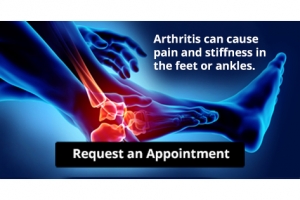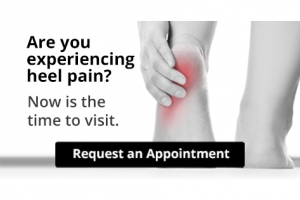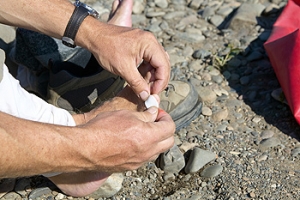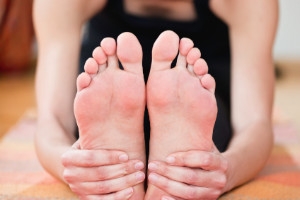Connect With Us
Blogs
Super User
Arthritis Can Cause Pain in the Feet
How to Treat Corns
When the skin on the foot rubs against a shoe, there is a chance a corn will develop. Typically, the pressure from this causes the skin to thicken; this may produce extreme pain, affecting the deeper layers of the skin. Hard corns are generally caused by poorly fitted shoes and may develop on the top of the toes. Corns that affect the area in between the toes are referred to as soft corns, and moisture from the toes may be the underlying reason for this condition. Occasionally, corns may develop on the soles of the feet, most likely caused by running or walking. There may be several treatment options available, including having a podiatrist trim the corn down, which will ease the pressure. Wearing shoes that fit properly, in addition to applying a moisturizer regularly will help to manage the corn once it’s trimmed. Chemical treatments may also be effective, which may help the corn to be less painful. Please consult with a podiatrist, especially if you have diabetes or poor circulation, for a recommendation for the best treatment options.
If you have any concerns regarding your feet and , contact Dr. Michael T. Hames of Florence Foot Center. Our doctor will treat your foot need.
Corns: What Are They? and How Do You Get Rid of Them?
Corns can be described as areas of the skin that have thickened to the point of becoming painful or irritating. They are often layers and layers of the skin that have become dry and rough, and are normally smaller than calluses.
Ways to Prevent Corns
There are many ways to get rid of painful corns such as wearing:
- Well-fitting socks
- Comfortable shoes that are not tight around your foot
- Shoes that offer support
Treating Corns
Treatment of corns involves removing the dead skin that has built up in the specific area of the foot. Consult with Our doctor to determine the best treatment option for your case of corns.
If you have any questions please feel free to contact our office located in Florence, Alabama . We offer the newest diagnostic and treatment technologies for all your foot need.
Read more about Corns: What Are They, and How Do You Get Rid of ThemCorns: What Are They, and How Do You Get Rid of Them
Corns are thickened areas on the skin’s surface, to the point of being irritating and sometimes painful. Commonly found on the feet, corns are circular or cone-shaped. They develop where there are areas of pressure or friction, such as on the little toe when it rubs up against shoes, or on the ball of your foot.
Corns are often confused with a callus, but there is a difference between them. Corns can be raised bumps that are painful to the touch. They consist of a rough, thick area of skin that may be dry or waxy. Corns tend to be surrounded by skin that is inflamed, and are usually much smaller than calluses.
Removing the dead skin that has built up is the key in treating corns. Salicylic acid medication is most common in accomplishing this. The acid works by dissolving keratin, which is the protein that makes up the majority of corns. You can purchase salicylic acid over-the-counter in products such as wart removers. It comes in a variety of forms such as medicated pads, drops, or creams. However, people who are diabetic should not use salicylic acid, but should instead consult their doctor immediately.
According to the product directions, applying the medication directly onto the corn will treat it. The top layer of the corn will begin to turn white after use. When that occurs, the layers of skin can then be peeled away, making the corn smaller. Shaving off corns with razors or other pedicure equipment is never a good idea. This can lead to infection. If your corn gets infected, and is not treated immediately, a visit to the doctor will be necessary.
Another way to treat corns and help prevent their return is by using orthotic inserts, fitted by a podiatrist. Inserts fit right into your shoes and adjusts the way your foot fits into your shoes. This fixes the way you walk. This will lower your chances of getting corns, and eliminate current corns by reducing rubbing from friction.
Surgery is rarely used to treat corns, but does occur on occasion. Surgery actually deals with the underlying issue that causes corns. During surgery, the bone is shaved and any abnormalities are corrected, thus reducing the amount of friction that occurs during walking.
To prevent corns, the first step is reducing friction. Always wear shoes that fit well and don’t rub your feet. Pads can be purchased if you notice rubbing developing. These pads can be purchased over-the-counter, and can be simply placed on the irritated area. Wearing cushioned insoles in your shoes can always reduce the friction, and making sure to wear well-fitting shoes. This will ensure that your foot is not being squeezed awkwardly, and prevent corns from forming in the first place.
The Benefits of Stretching the Feet
 General health is often improved by stretching and exercising your feet on a routine basis. While walking may be the most beneficial exercise, flexibility and resistance exercises can be just as important in promoting good health and avoiding injury to the feet. There are many forms of exercise to choose from, many of which can be integrated into your daily routine. Before beginning, it’s important to allow time for simple stretching; this can help in strengthening the muscles of the feet. Some exercises may include circling your foot in one direction, then changing to the other direction. Dropping the heel while standing on a step is another effective stretch for the feet. It's important to remember to contact your podiatrist if you experience pain at any time during these stretches.
General health is often improved by stretching and exercising your feet on a routine basis. While walking may be the most beneficial exercise, flexibility and resistance exercises can be just as important in promoting good health and avoiding injury to the feet. There are many forms of exercise to choose from, many of which can be integrated into your daily routine. Before beginning, it’s important to allow time for simple stretching; this can help in strengthening the muscles of the feet. Some exercises may include circling your foot in one direction, then changing to the other direction. Dropping the heel while standing on a step is another effective stretch for the feet. It's important to remember to contact your podiatrist if you experience pain at any time during these stretches.
Stretching the feet is a great way to prevent injuries. If you have any concerns with your feet consult with Dr. Michael T. Hames from Florence Foot Center. Our doctor will assess your condition and provide you with quality foot treatment.
Stretching the Feet
Being the backbone of the body, the feet carry your entire weight and can easily become overexerted, causing cramps and pain. As with any body part, stretching your feet can serve many benefits. From increasing flexibility to even providing some pain relief, be sure to give your feet a stretch from time to time. This is especially important for athletes or anyone performing aerobic exercises, but anyone experiencing foot pain or is on their feet constantly should also engage in this practice.
Great ways to stretch your feet:
- Crossing one leg over the others and carefully pull your toes back. Do 10-20 repetitions and repeat the process for each foot
- Face a wall with your arms out and hands flat against the wall. Step back with one foot and keep it flat on the floor while moving the other leg forward. Lean towards the wall until you feel a stretch. Hold for 30 seconds and perform 10 repetitions for each foot
- Be sure not to overextend or push your limbs too hard or you could risk pulling or straining your muscle
Individuals who tend to their feet by regular stretching every day should be able to minimize foot pain and prevent new problems from arising.
If you have any questions, please feel free to contact our office located in Florence, Alabama . We offer the newest diagnostic and treatment technologies for all your foot care needs.
Read more about Stretching Your Feet
















